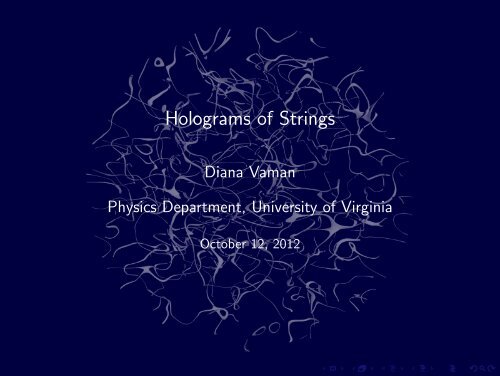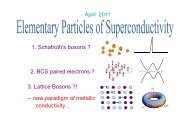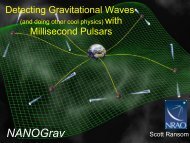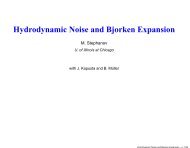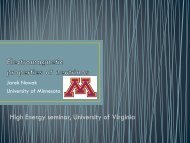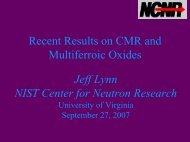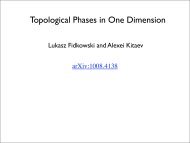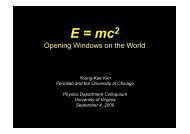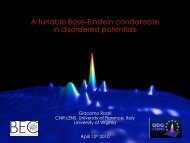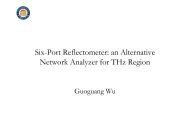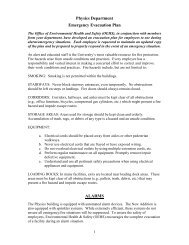Holograms of Strings - Department of Physics - University of Virginia
Holograms of Strings - Department of Physics - University of Virginia
Holograms of Strings - Department of Physics - University of Virginia
You also want an ePaper? Increase the reach of your titles
YUMPU automatically turns print PDFs into web optimized ePapers that Google loves.
<strong>Holograms</strong> <strong>of</strong> <strong>Strings</strong><br />
Diana Vaman<br />
<strong>Physics</strong> <strong>Department</strong>, <strong>University</strong> <strong>of</strong> <strong>Virginia</strong><br />
October 12, 2012
Outline<br />
◮ Introduction to String Theory and AdS/CFT<br />
◮ <strong>Holograms</strong> <strong>of</strong> strings<br />
◮ Applications to strongly coupled hot plasmas<br />
◮ Jet quenching<br />
◮ Hydrodynamic expansion coefficients: first and second order<br />
coefficients<br />
◮ Building holography for aging systems bottom-up
Introduction to String Theory<br />
t<br />
x<br />
Point particle evolution : worldine<br />
y<br />
∫<br />
S = −m<br />
√<br />
dτ −Ẋ µẊ ν g µν (X ) ∼ Length<br />
p µ p µ = −m 2
Introduction to String Theory<br />
String evolution : worldsheet<br />
∫ √<br />
S = −T dτdσ −(Ẋ ·Ẋ )(X ′ · X ′ ) + (X ′ · Ẋ )2 ∼ Area<br />
∫<br />
S = − T 2<br />
dτdσ √ − det hh αβ ∂ α X · ∂ β X<br />
T = 1<br />
2πα ′ α ′ = Regge slope = l 2 s = string length 2
Introduction to String Theory<br />
String equations <strong>of</strong> motion = Wave equations<br />
□X = Ẍ − X ” = 0<br />
Same as for a vibrating violin string!<br />
∫<br />
S violin =<br />
∫<br />
dt<br />
[<br />
]<br />
µ<br />
dx<br />
2 (ẏ)2 − T 2 (y ′ ) 2<br />
Also, same as for a violin string, two types on endpoint conditions: free<br />
(Neumann) or fixed (Dirichlet).
Introduction to String Theory<br />
Modes <strong>of</strong> vibrations for the open and closed strings:<br />
Energy levels for the quantum violin string<br />
E<br />
Just an infinite bunch <strong>of</strong> harmonic oscillators.
Introduction to String Theory<br />
But, the relativistic string is more constrained: invariance under<br />
reparametrizations <strong>of</strong> the worldsheet means that the energy as measured<br />
on the worldsheet (and the stress tensor in general) is zero:<br />
Ẋ · Ẋ + X ′ · X ′ = 0, Ẋ · X ′ = 0<br />
The string spectrum is an infinite tower <strong>of</strong> particles, with arbitrarily high<br />
spin classified by the Lorentz group<br />
S<br />
S<br />
01<br />
−4<br />
α’<br />
00 11<br />
2<br />
00 11<br />
01<br />
closed<br />
m 2 −1<br />
α’<br />
1<br />
open<br />
m 2<br />
And, the number <strong>of</strong> space-time dimensions is fixed (26 or 10).
Introduction to String Theory<br />
Open string with Neumann (free) and Dirichlet (fixed) boundary<br />
conditions:<br />
D−brane<br />
Α<br />
µ<br />
Α µ<br />
X || : Neumann b.c. and X ⊥ : Dirichlet b.c.<br />
At the massless level find a spin one particle (photon) and several (as<br />
many as transverse directions to the D-brane) scalar particles.<br />
The D-brane is dynamical (it fluctuates). Its action is derived by<br />
requiring one-loop conformal invariance for the open string. Conformal<br />
invariance: scaling symmetry (the theory looks the same at any scale).
For a space-time filling D-brane<br />
S = − 1<br />
∫<br />
4πα<br />
∫ws<br />
′ dτdσ ∂ α X µ ∂ α X µ + dτ A µ ∂ τ X µ<br />
bdy ws<br />
√<br />
β = 0 −→ EOM <strong>of</strong> Born − Infeld action : L = det(η µν + 2πα ′ F µν )<br />
For small α ′ , get the Maxwell action<br />
L = 1 4 F µνF µν ∼ ⃗ E 2 − ⃗ B 2
For closed strings, conformal (scale) invariance<br />
S = − 1<br />
[<br />
4πα<br />
∫ws<br />
′ dτdσ ∂ α X µ ∂ α X ν g µν (X ) + i∂ α X µ ∂ β X µ ɛ αβ B µν (X )<br />
]<br />
+ α ′ Φ(X )R ws<br />
requires that the space-time metric satisfies Einstein equations<br />
R µν = B,Φ−sources,<br />
R µν = 0 in vacuum<br />
In general, conformal invariance implies the EOM <strong>of</strong> Einstein action<br />
(+more)<br />
[<br />
]<br />
√<br />
L = 1<br />
G N<br />
− det ge<br />
−2Φ<br />
R − 1 2 H µνρH µνρ + 4∂ µ Φ∂ µ Φ<br />
It’s the tail wagging the dog! the string cannot exist in other spacetimes<br />
than those compatible with general relativity.
Superstrings<br />
Supersymmetry relates particles with different spin-statistics:<br />
supermultiplet=(bosons, fermions)<br />
Infinitesimal transformation<br />
δf = ɛ∂b δb = ɛf ”δ 2 ”b = ”ɛ 2 ”∂b<br />
Superstrings live in 10 dimensions. At the massless level (or α ′ → 0) find<br />
◮ open strings: superMaxwell multiplet (A µ and a spin 1/2 field,<br />
gaugino)<br />
◮ closed strings: supergravity multiplet (g µν , a spin 3/2 field,<br />
gravitino, plus a bunch <strong>of</strong> other fields)
D-branes in supergravity<br />
D-branes have energy, they gravitate, and curve the space around them.<br />
Mass/Energy ↔ Geometry/Metric.<br />
This is much like having an object with a mass M source the Einstein<br />
equation. In the limit <strong>of</strong> weak gravitational field, the geodesic motion <strong>of</strong><br />
some test particle yields Newtonian dynamics and gravity.<br />
For flat D3-branes (extended in space-time) we have a dual description
How to think <strong>of</strong> AdS 5 × S 5 ?<br />
S 5 is a 5-dimensional constant positive curvature space (sphere):<br />
Y1 2 + Y2 2 + Y3 2 + Y4 2 + Y5 2 + Y6 2 = R 2<br />
AdS 5 is a 5-dimensional constant negative curvature space:<br />
−X−1 2 − X0 2 + X1 2 + X2 2 + X3 2 + X4 2 = −R 2
Back to D3’s<br />
Dual perspective in the low energy limit (α ′ → 0):<br />
◮ Solutions <strong>of</strong> supergravity<br />
ds 2 = √ h(r)dx µ dx µ + 1 √<br />
h(r)<br />
(dr 2 + r 2 dΩ 2 5)<br />
h(r) = 1 + 4πNg sα ′2<br />
r 4<br />
≡ 1 + R4<br />
r 4<br />
ds 2 = R2<br />
z 2 (dx µ dx µ + dz 2 ) + R 2 dΩ 2 5 = ds 2 AdS + ds 2 S<br />
◮ 4d field theory = maximally supersymmetric extension <strong>of</strong> QCD or<br />
N = 4 superYang Mills<br />
SU(N) gauge field A µ , 4 spin 1/2 fields, and 6 scalars<br />
All fields transform as in the adjoint representation <strong>of</strong> SU(N).
Holography<br />
Maldacena: The 4d maximally susy gauge theory with gauge group<br />
SU(N), at strong coupling, is dual to superstring theory on the curved<br />
background AdS 5 × S 5 .<br />
◮ Identification <strong>of</strong> symmetries:<br />
-conformal symmetry SO(4, 2) is a(n) symmetry (isometry) <strong>of</strong> the<br />
AdS 5 background<br />
-R-symmetry SO(6) is a(n) symmetry (isometry) <strong>of</strong> the S 5<br />
background<br />
◮ Identification <strong>of</strong> couplings<br />
g 2 YM<br />
4π = g s, g 2 YMN = R2<br />
α ′2 , α′ → 0, R ≫ √ α ′<br />
◮ This is a strong/weak duality. Difficult to prove, but powerful in its<br />
applications. Simply replace the strongly coupled system by a<br />
gravitational weakly coupled one.
<strong>Holograms</strong> <strong>of</strong> strings<br />
Consider the field theory, and imagine that it interacts with a<br />
gravitational wave. This coupling involves the metric fluctuation h µν with<br />
the energy-stress tensor T µν (recall that the energy density is ∼ ⃗ E 2 + ⃗ B 2 ).<br />
This metric fluctuation on the boundary <strong>of</strong> AdS propagates in the bulk.<br />
Expectation values <strong>of</strong> the energy-stress tensor are computed by<br />
evaluating the supergravity action on AdS 5 , pertubed by the boundary<br />
fluctuation h µν .<br />
Similarly, a background field A µ will source a current ¯ψγ µ ψ in the field<br />
theory.<br />
Expectation values <strong>of</strong> the current are computed by evaluating the<br />
supergravity action, perturbed by the boundary fluctuation A µ .
µ<br />
x<br />
h h<br />
µυ<br />
ρσ z=0<br />
bulk gravitons<br />
interaction vertex<br />
holographic radial direction<br />
z=infinity<br />
More concretely,<br />
δ 3 S sugra<br />
〈T µν (x 1 )T ρσ (x 2 )T λτ (x 3 )〉 =<br />
δh µν (x 1 )δh ρσ (x 2 )δh λτ (x 3 )<br />
h (x ) µν 1<br />
Witten diagram<br />
bdy<br />
AdS<br />
z=0<br />
Bulk AdS<br />
Supergravity<br />
vertex<br />
h ( x )<br />
ρσ 2<br />
h ( x ) λτ 3
◮ bulk gravitons - holograms <strong>of</strong> stress-energy tensor<br />
◮ bulk gauge fields - holograms <strong>of</strong> currents<br />
◮ other operators: bulk scalars with mass m - holograms <strong>of</strong> scalar<br />
operators with conformal dimension ∆ = 2 + √ 4 + m 2 R 2 etc.<br />
◮ quarks? these particles transform in the fundamental representation<br />
<strong>of</strong> SU(N) [In QCD there are 3 quarks, and 8 gluons, and the gauge<br />
field is SU(3).] Need strings with one end on the D3’s and one end<br />
on some other (”flavor”) D-brane:<br />
µ<br />
x<br />
z=0<br />
holographic radial direction<br />
quark<br />
z=infinity<br />
Still, this is not the holographic dual <strong>of</strong> a confining gauge theory.<br />
For that, the AdS geometry needs to be replaced by something else.
◮ mesons? these are q¯q bound states. holographic dual?<br />
◮ for small spin - fluctuations <strong>of</strong> the flavor D-brane<br />
◮ for large spin - open spinning strings<br />
◮ baryons? these are qqq bound states. holographic dual?<br />
A baryon vertex (wrapped D-brane on S 5 ) with N open strings<br />
connecting the boundary to it.<br />
ω<br />
meson w spin
Applications to strongly coupled hot plasmas<br />
Quark-Gluon Plasma<br />
◮ At room temperature, quarks and gluons are always confined inside<br />
colorless objects (hadrons: baryons, mesons).<br />
◮ At very high temperature, quarks and gluons deconfine and form a<br />
QG plasma.<br />
At T → ∞ the interactions vanish and the quarks and gluons are<br />
free, non-interacting particles (QGP gas).
In the lab, QGP is created in relativistic heavy ion collisions at RHIC<br />
(Brookhaven National Lab) and LHC (Geneva, CERN).<br />
RHIC: Au-Au collisions √ s NN ∼ 200GeV , T ∼ 300MeV<br />
LHC Pb-Pb collisions √ s NN ∼ 2.76TeV , T ∼ 450MeV<br />
Cartoon <strong>of</strong> a collision event
◮ Properties <strong>of</strong> the QGP: weakly or strongly coupled?<br />
Collective behavior <strong>of</strong> the observed final-state hadrons (anisotropy <strong>of</strong><br />
the momenta distribution in the ellipse angle): suggests that RHIC<br />
and LHC QGP is a fluid, which moreover exhibits a very small<br />
viscosity (ideal, strongly coupled fluid).<br />
η<br />
s<br />
¯h<br />
4πk B<br />
0<br />
g 2 N c<br />
[Kovtun, Son, Starinets 2004]<br />
◮ Probes <strong>of</strong> QGP? it exists for 5fm (or, in proper units, 10 −23 s), so<br />
external probes cannot be used. Use hard probes created during the<br />
collision - jet quenching.
If the deconfined quarks and gluons interact strongly, this is a strongly<br />
coupled plasma. In a range <strong>of</strong> temperatures above T c , hot QCD is similar<br />
to hot superYang-Mills: non-supersymmetric, almost conformal.<br />
So, its holographic dual is not unlike AdS at finite temperature, that is<br />
AdS with a black hole in it.<br />
Black holes radiate, and the (Hawking) radiation has a thermal spectrum,<br />
with a temperature which can be computed from geometry.<br />
Holographically, identify the Hawking temperature and the dual field<br />
theory temperature.
Real-time AdS/CFT<br />
We are interested in dynamical processes which happen near equilibrium.<br />
Develop real-time AdS-CFT tools. In real-time (as opposed to<br />
Euclidean/imaginary time) there is the issue <strong>of</strong> time-ordering:<br />
Feynman correlator G F ∼ 〈T φ(x 1 )φ(x 2 )〉<br />
1<br />
∼<br />
(⃗x 1 − ⃗x 2 ) 2 − (t 1 − t 2 ) 2 + iɛ<br />
Wightman correlator G + W ∼ 〈φ(x 1)φ(x 2 )〉<br />
1<br />
∼<br />
(⃗x 1 − ⃗x 2 ) 2 − (t 1 − t 2 − iɛ) 2<br />
Causal Retarded correlator<br />
G R ∼ G F − G − W<br />
support on the forward light − cone
Veltman’s circling rules can be transplanted to gravity on AdS<br />
∆<br />
F<br />
_<br />
∆<br />
∆ +<br />
∆<br />
*<br />
F<br />
Properties:<br />
◮ Largest time identity: Sums <strong>of</strong> all diagrams with all vertices circled<br />
or uncircled is zero<br />
◮ Retarded n-point function: Assume that external leg 1 has the<br />
largest time. Then the retarded n-point function is the sum <strong>of</strong> all<br />
diagrams with vertices circled or un-circled, with the exception <strong>of</strong> 1<br />
which remains uncircled.<br />
In real-time finite temperature formalism, use Schwinger-Keldysh path<br />
t i<br />
t<br />
f<br />
integration contour<br />
t − i i<br />
β<br />
− iσ t f
Kobes & Semen<strong>of</strong>f: Trade the Schwinger-Keldysh propagator for circling<br />
rules, which are the same as at zero temperature.<br />
The retarded propagator determines completely all other components <strong>of</strong><br />
the SK propagator<br />
G R =θ(t)〈e −βH [φ 1 (x), φ 1 (0)]〉<br />
G F =Re(G R ) + iIm(G R )coth(E/2T )<br />
In AdS-CFT, causal propagators have specified incoming/outgoing<br />
boundary conditions at the black hole horizon; the others can be<br />
determined from them; also, one more prescription applies: the bulk<br />
region is integrated only up to horizon.<br />
Real-time 2-point functions known since 2002 [Son and Starinets, Son<br />
and Herzog].<br />
Real-time higher n-point functions known since 2010 [Arnold, Barnes,<br />
DV, Wu].<br />
Applications? Beyond linear response.
Jet quenching<br />
Jet: a colimated spray <strong>of</strong> hadrons resulted from the QCD branching <strong>of</strong> a<br />
hard parton.<br />
Jet (here): the hard parton moving through the hot medium.<br />
Jet quenching: jet interacts with the medium, leading to a marked<br />
decrease in its energy.<br />
Possibilities:<br />
◮ the jet interacts weakly with the medium and with the emitted<br />
radiation.<br />
◮ the jet interact strongly with the medium, and weakly with the<br />
emitted radiation.<br />
◮ all interactions are strong.
Different kinds <strong>of</strong> jets:<br />
◮ - heavy quarks and the drag force experienced due to medium<br />
interactions - open strings with one end-point on the horizon,<br />
dragged by an invisible hand such that it moves with constant<br />
velocity, the other endpoint trailing behind, approaching the horizon<br />
◮ - gluon-like jets - holograms <strong>of</strong> closed folded-back strings with both<br />
ends through the horizon [Gubser et al 2008]<br />
◮ - two light-quark jets moving in opposite directions - holograms <strong>of</strong><br />
open strings with the endpoints moving farther from each other,<br />
falling in the black hole [Chesler et al 2008]<br />
0.<br />
u<br />
u h<br />
0.5<br />
1.<br />
6 4 2 0 2 4 6<br />
T x<br />
All these scenarios begin by setting up the initial problem on the gravity<br />
side. Not an easy translation to an initial condition on the field theory<br />
side.
The question: how far does a localized, highly energetic excitation travel<br />
through the hot plasma, before coming to a stop and thermalizing?<br />
Answer: it depends. For a weakly coupled plasma, the stopping distance<br />
dependence with the energy E is l stop ∼ E 1/2 . [Arnold, Moore, Yaffe]<br />
For a strongly coupled plasma, with long strings as the duals <strong>of</strong> the jet,<br />
l stop ∼ [E/(T √ λ)] 1/3 .<br />
What about jets whose duals are short strings (supergravity<br />
fluctuations)? [Arnold, Vaman 2010,2011] These are easily amenable to<br />
an initial problem on the field theory side.<br />
Example: perturb the boundary theory by some classical field, sourcing a<br />
current.<br />
Analogy<br />
W<br />
+<br />
E<br />
u<br />
d<br />
The q¯q pair move to right, carrying conserved charges, isospin. Track<br />
their location by doing an isospin measurement!
u=1<br />
.<br />
.<br />
x 3<br />
.<br />
x 3<br />
.<br />
x 3<br />
stopping distance x 3 stop<br />
stopping distance x 3 stop<br />
time<br />
.<br />
x 3 0<br />
boundary<br />
x 3<br />
0<br />
boundary<br />
j µ<br />
x 3<br />
x 3<br />
stopping distance<br />
x 3 1<br />
u<br />
horizon<br />
(a)<br />
1<br />
u<br />
horizon<br />
(b)<br />
The problem reduces to a computation <strong>of</strong> a 3-point current correlator<br />
”〈boot|eye|boot〉”.<br />
x1<br />
u=1<br />
x<br />
u=1<br />
x2<br />
L<br />
R<br />
u=0<br />
x 2<br />
x 3<br />
x1<br />
boundary<br />
(a)<br />
u=0<br />
(b)
The source<br />
q 0 q 0 q 3 q 0 q 3<br />
L −1<br />
L −1<br />
L −1<br />
E E E<br />
~ ε<br />
(a)<br />
The result<br />
q 3<br />
E E E<br />
(b)<br />
(c)<br />
t<br />
charge deposited<br />
exponential<br />
fall−<strong>of</strong>f<br />
∝ (x + ) −9 x + x<br />
(EL) 1/4 T −1 E 1/3 T −4/3<br />
(EL) 1/4 T −1 E 1/3 T −4/3<br />
(a)<br />
(b)<br />
3<br />
Typical l stop ∼ E 1/4 . Maximal l stop ∼ E 1/3 .<br />
Source (b) wavepacket localized in the bulk. Amenable to a classical<br />
treatment: point particle following a geodesic trajectory<br />
( ) 1/4<br />
E<br />
l stop ∼<br />
2<br />
−q µ q µ<br />
.
Hydrodynamics <strong>of</strong> the strongly coupled plasma<br />
The QCD plasma at RHIC and LHC is a ”perfect fluid”.<br />
4π η<br />
h s<br />
200<br />
150<br />
Helium 0.1MPa<br />
Nitrogen 10MPa<br />
Water 100MPa<br />
100<br />
50<br />
Viscosity bound<br />
0<br />
1 10 100<br />
T, K<br />
[Kovtun,Son,Starinets, 2004]
Hydrodynamics- long wavelength/long distance effective description <strong>of</strong> a<br />
classical or quantum many-body system at finite T .<br />
Relativistic hydro - the quantum fluid is constrained by Lorentz (think<br />
QGP)<br />
Long wavelength modes - ω, k ≪ T<br />
Hydrodynamic equations - EOS and conservation laws (e.g.<br />
energy-momentum tensor is conserved: ∇ µ T µν = 0) plus an expansion in<br />
small gradients (small ω, k). The coefficients <strong>of</strong> this expansion are called<br />
hydro coefficients.<br />
At linear order - viscosity (shear + bulk).<br />
Holographic bound (which later it was found to be violated by 1/N terms<br />
in a large class <strong>of</strong> examples) for the shear viscosity η/s = 1/(4π).<br />
[Kovtun, Son, Starinets].<br />
QGP: η/s ∼ (1 − 2) × 1/(4π).
Decompose the stress tensor <strong>of</strong> a CFT into an equilibrium piece and a<br />
non-equilibrium part, with the latter expanded in gradients, which are<br />
taken to be small:<br />
T µν = T eq µν + Π µν , T eq µν = (ɛ + P)U µ U ν + Pg µν<br />
(<br />
)<br />
Π µν = −ησ µν + ητ 〈 Π U · ∇σ µν〉 + 1 3 ∇ · Uσµν<br />
)<br />
+κ<br />
(R 〈µν〉 − 2U ρ U σ R ρ〈µν〉σ<br />
+λ 1 σ 〈µ ρσ ν〉ρ + λ 2 σ 〈µ ρΩ ν〉ρ + λ 3 Ω 〈µ ρΩ ν〉ρ + . . .<br />
where σ and Ω are the fluid’s shear and vorticity tensors:<br />
σ µν = 2∇ 〈µ U ν〉 ≡ 1 2 ∆µρ ∆ νσ (2∇ ρ U σ + 2∇ σ U ρ ) − 1 3 ∆µν ∆ ρσ 2∇ ρ u σ<br />
Ω µν = 1 2 ∆µρ ∆ νσ (∇ ρ U σ − ∇ σ U ρ )<br />
and where ∆ µν are transverse (to the fluid’s velocity) projectors.
◮ Compute the fluid’s response to a small, slowly varying gravitational<br />
perturbation, and derive Kubo-type formulae for 2nd order hydro<br />
coefficients. [Moore, Sohrabi 2010]<br />
∫<br />
〈T µν (z)〉 h = 〈T µν 〉 h=0 − 1 2<br />
d 4 µν ρσ<br />
x G ra (z; x)h ρσ (x)<br />
∫ ∫<br />
d 4 x d 4 µν ρσ τζ<br />
y G raa (z; x, y)h ρσ (x)h τζ (y) + . . .<br />
+ 1 8<br />
◮ Solve the conservation law ∇ µ T µν = 0, iteratively, in the fluid’s<br />
velocity U µ , and order-by-order in the metric fluctuations =⇒ get<br />
Kubo-type formulae! [Arnold, DV, Wu, Xiao, 2011]
lim ∂ ω1 ∂ ω2 lim G xy xz yz = −λ 1 + ητ Π<br />
ω 1→0<br />
ω 2→0<br />
lim<br />
ω 2→0<br />
k 1→0<br />
∂ k2 ∂ ω1<br />
lim<br />
k 1→0<br />
k 2→0<br />
k1→0<br />
k 2→0<br />
lim<br />
ω 2→0<br />
k 1→0<br />
∂ k1 ∂ k2<br />
G xy yz tx = − 1 4 λ 2 + 1 2 ητ Π<br />
lim<br />
ω 1→0<br />
ω 2→0<br />
G xy 0x 0y = − 1 4 λ 3<br />
xy<br />
x<br />
xy<br />
x<br />
L<br />
R<br />
u=1<br />
xy<br />
xz<br />
yz<br />
u=0<br />
xz<br />
x2<br />
L<br />
xy<br />
x0<br />
R yz<br />
u=1<br />
u=0<br />
xz<br />
x2<br />
u=1<br />
yz<br />
x1<br />
u=1<br />
yz<br />
x1<br />
(a)<br />
(b)<br />
xy<br />
x<br />
xy<br />
x<br />
L<br />
xy<br />
xz<br />
R y0<br />
u=1<br />
u=0<br />
xz<br />
x 2<br />
L<br />
R<br />
xy<br />
x0<br />
y0<br />
u=1<br />
u=1<br />
u=0<br />
xz<br />
x2<br />
u=1<br />
yz<br />
x 1<br />
yz<br />
x1<br />
Holography<br />
(d)<br />
(c)
lim<br />
k 1 →0<br />
k 2 →0<br />
lim<br />
k 1 →0<br />
k 2 →0<br />
[<br />
xy yz xz<br />
GAdS = N2 c 1<br />
2 4 π 2 2 3 − i ω 1 + ω 2<br />
[<br />
xy yz xz<br />
Ghydro = N2 c<br />
2 4 π 2<br />
◮ λ 1 : λ 1 = N2 c<br />
2 6 π 2 , ⇒ λ 1 = N2 c T 2<br />
16 .<br />
]<br />
2 2 + . . .<br />
2 2 − (ω 1ω 2 + ω1 2 + ω2 2 )(ln 2 − 1)<br />
]<br />
1<br />
3 ¯ɛ−iη(ω 1+ω 2 )+ητ Π (ω1 2 +ω2 2 +ω 1ω 2 )− 1 2 κ(ω2 1 +ω2 2 )−λ 1ω 1 ω 2 +. . .<br />
lim<br />
ω 1 →0<br />
ω 2 →0<br />
lim<br />
ω 1 →0<br />
ω 2 →0<br />
◮ λ 3 : λ 3 = 0.<br />
[<br />
xy ty tx<br />
GAdS = N2 c<br />
2 6 π 2 − 1 ]<br />
2 + (k2 1 + k2 2 ) + . . .<br />
xy ty tx<br />
Ghydro = − 1 3 ¯ɛ + 1 2 κ(k2 2 + k2 1 ) − 1 4 λ 3k 1 k 2 + . . .<br />
lim<br />
k 1 →0<br />
ω 2 →0<br />
lim<br />
k 1 →0<br />
ω 2 →0<br />
xy yz tx<br />
GAdS = N2 c<br />
2 6 π 2 ω 1k 2 + . . .<br />
xy yz tx<br />
Ghydro = (− 1 4 λ 2 + 1 2 ητ Π)ω 1 k 2 + . . .<br />
◮ λ 2 :<br />
λ 2 = − N2 c<br />
2 5 π 2 ln 2 ⇒ λ 2 = − 1 8 N2 c T 2 ln 2.
Building AdS/CFT bottom-up: Aging Dynamics<br />
Non-equlibrium criticality/ Aging<br />
Hankel, Pleimling: A physical many-body system will undergo aging if<br />
the relaxation process towards its stationary state(s) exhibits<br />
-slow dynamics (non-exponential relaxation)<br />
-breaking <strong>of</strong> time-translation invariance<br />
-dynamical scaling.<br />
Example: take a feromagnetic spin system, which is prepared in a high<br />
temperature state, then quenched below its critical temperature and left<br />
to evolve freely. The size <strong>of</strong> the clusters <strong>of</strong> ordered spins, which form and<br />
grow, is time-dependent: L ∼ t 1/z .<br />
Features: two-point correlation functions depend on both times, not only<br />
on their difference.
Start with the symmetries.<br />
Schrodinger group<br />
t → t ′ = αt + β<br />
γt + δ<br />
αδ − βγ = 1<br />
,⃗r → ⃗r ′ =<br />
R⃗r + ⃗vt + ⃗a<br />
γt + δ<br />
where R is a rotation matrix. The various Schrodinger group<br />
transformations are: time and spatial-translation (β,⃗a), spatial rotations<br />
(R), Galilei transformations (⃗v), dilatations (δ) and special Schrodinger<br />
transformation (γ).<br />
For Aging, eliminate time-translations. Compute 2 and 3-point<br />
correlation functions (for scalar operators they are left invariant by the<br />
Aging algebra generators). [Minic, DV, Wu].<br />
To construct the holographic dual, ask that the algebra <strong>of</strong> the Age<br />
generators is the algebra <strong>of</strong> the Killing vectors (generators <strong>of</strong> metric<br />
symmetries). Reverse-engineer the algebra to give you a metric. Ask if<br />
the metric derived yields compatible expressions for 2 and 3-point<br />
correlators.
Conclusions<br />
AdS/CFT and its various extensions AdS/QCD, gauge/string duality,<br />
AdS/CMT have given us an analytic window into strongly coupled<br />
systems. There are many string theory constructions dual to confining<br />
gauge theories, but none is yet hailed as the QCD holographic dual.<br />
However, the strongly coupled plasma studied at RHIC and LHC and<br />
finite temperature AdS/CFT have similar characteristics. Therefore<br />
calculations performed using AdS/CFT techniques (e.g. hydrodynamic<br />
coefficients, jet quenching) are in fairly good agreement with<br />
experimental results.<br />
Currently, many people are exploring and extending these techniques to<br />
various condensed matter systems.
Thanks!<br />
I would like to thank my past and current collaborators who have kept<br />
me busy over the last few years:<br />
Peter Arnold, Eddie Barnes, Djordje Minic, Berndt Muller, Rob Leigh,<br />
Leo Pando Zayas, Phil Szepietowski, Wei Xiao, Di-Lun Yang, Ed Yao,<br />
Gabriel Wong, Chaolun Wu (graduated 2012, now at U. Chicago).


